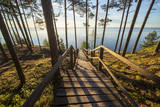| Нo | Название | Описание |
|---|---|---|
|
The trail reveals one of the rare bluffs of the Gulf of Riga – the Ēvaži Bluff (up to 15m high, a beautiful scenery opens from its watching platform) and the seashore forests. The trail starts from the main road and crosses a biotope “Wooded dunes of the coast” (according to Habitats Directive, Annex II), which is frequently observed by the sea. One can climb down the stairs to an extraordinary beach with narrow seashore and Black Alders growing almost in the sea. There are occasional puddles which make shelter for Natterjack Toad (Bufo calamita), a protected amphibian. Deeper pools are inhabited by three-spined stickleback (Gasterosteus aculeatus), they are food for fish-eating birds. In the second half of the summer, Common Shelduck (Tadorna tadorna) can be observed in the sea. About two kilometres to the South, there is Melnsils, one of the Liv fishing villages, famous for the stories about a channel which was once dug to drain coastal lakes into the sea, as well as about Trommel, the chief of robbers. The trail is in the Slītere National Park. |
||
|
Посетителям питомника в сопровождении гида предлагают увидеть благородных оленей, ланей и муфлонов, услышать истории об особенностях выращивания животных. Ведется селекционная работа. |
||
|
Находится на острове Пилс между Лиелупе и Дриксу. Построенный в стиле барокко дворец проектировал известный итальянский архитектор Франческо Бартоломео Растрелли, что является его наиболее значительной работой раннего творчества. Во дворце находится Латвийский сельскохозяйственный университет. В 1968 г. здесь создан музей.+ 371 63005617. В юго-восточном крыле цокольного этажа дворца расположены родовые гробницы правителей Курземе и Земгале – Кетлеров и Биронов (период времени с 1569 по 1791 гг.), где к осмотру представлены 18 отреставрированных саркофагов. |
||
|
Действительно вкусный яблочный сок. Биологическое хозяйство, выращивающее яблоки и облепиху. Посетители могут осмотреть хозяйство, сады, производственные помещения и оборудование, а также продегустировать и купить соки. |
||
|
Создан в 900 году у места впадения речки Персес в Даугаву (теперь – в водохранилище Плявиньской ГЭС), в нем можно осмотреть шведские пушки 17 века и памятники средневековых могил. В парке (перед школой) находится восстановленный фонтан „Голова фавна”, который в тридцатые годы 20 века находился недалеко от легендарного водопада Персес (сейчас под водой), место которого обозначено расположенной на берегу реки каменной скульптурой „Девушка Персе” (автор: Я. Зихманис). Дорожка ведет вдоль 11-метровой деревянной скульптуры «Вечности», созданной скульптором Г.Бурвисом, и созданной братьями Руранами «Совушки». |
||
|
Из выращенных своими руками овощей и плодов готовят вкусное варенье, сиропы, джемы и чатни, а также сушат плоды. Дегустация и покупка продукции. Предлагается осмотр фермы виноградных улиток и дегустацию улиток, которые приготовлены в бургундском вкусе. Организуют детские лагеря. |
||
|
Находится в центре Мадоны. В приготовлении блюд используют фрукты и овощи из собственного хозяйства. Латышская кухня: Холодный свекольный, щавелевый суп и суп с лисичками, серый горох с салом, селедка, ячменная каша со шкварками, грибной соус, варенье (семь видов), круглый год десерт из малины или клубники. Тонкие блины с картофельной, тыквенной, яблочной и рабарбаровой начинкой, сырники. Домашние соки, травяные чаи, коктейли из мороженого. Особое блюдо: Домашний бисквитный пирог со свежими ягодами. |
||
|
Парк усадьбы Стелмуже, что находится к югу от озера Стелмуже, был заложен в середине XVIII в. На холме здесь стоит костёл Креста Господня, к которому со всех сторон стекаются извилистые дорожки. Среди растительности преобладают липы, клены, дубы, вязы, березы, ели, ясени, сосны. У подножия холма можно найти Колодец счастья, прогуляться по дубовой аллее. Деревня Стелмуже также славится своим огромным дубом. Это самый старый и самый толстый дуб в Литве и одно из самых древних деревьев во всей Европе. Его возраст предположительно составляет 1500–2000 лет, в диаметре он достигает рекордных 3,5 м (чтобы обхватить его ствол, потребуется 8–9 человек), а его высота составляет 23 м. |
||
|
Музей хлеба, пекарня и гостевой дом, расположенные всего в 0,6 км от Аглонской базилики. Посетители могут проследить путь хлеба от зернышка до буханки, которую каждый может сделать сам. Предлагается дегустация хлеба (и травяные чаи) с театрализованным представлением на крестины, свадьбу, юбилей и др. На стол ставятся клёцки, крапивники, суп из сушеных грибов или уха из речной рыбы. В музее можно приобрести свежеиспеченный хлеб и работы местных ремесленников. Латышская кухня: Суп из озерной рыбы, клёцки и крапавники. Особое блюдо: Суп из сушеных грибов. |
||
|
The impressive Gauja River valley and its best natural and cultural landscapes can be seen from Paradīze (Gleznotāji) Hill, the Sigulda castle ruins, the aerial tram, the Ferris wheel, the Ziediņi and Pilsēta ski trails, the area of the bobsled and sledding trail, Ķeizarskats, the viewing area of the Velnala cliffs, the mountain bike route of Sigulda (on the right bank of the Gauja, particularly when the trees are bare), the area of the Krimulda castle ruins, Dainu Hill, and the Turaida castle tower.
|
||
|
Группам гурманов хозяйка предлагает поучаствовать в различных кулинарных мастерских (2- 3 урока): в «Мастерской сладкой сдобы», «Мастерской сезонных нетрадиционных овощных блюд», «Мастерской пицц», «Приготовление конопляного стака (масла)» и др. Для тех, кто сам не хочет готовить, предлагается неторопливое деревенское угощение с осмотром хозяйства, виноградного сада и рассказами о жизни в деревне. |
||
|
Кафе расположено непосредственно у старинного кирпичного кулдигского моста, отсюда открывается прекрасный вид на «Вентас Румбу» – самый широкий водопад в Европе. Блюда гриль летом, бургеры, стейки, шашлыки и кондитерские изделия. |
||
|
Двигаясь по дороге Нерете – Илуксте, храм виден издалека. Церковь построена в 1805 году, а отреставрирована - в 1888 г. Внутри церкви сохранился первоначальный алтарь, кафедра и фасад органа. У церкви захоронены немецкие солдаты, павшие во время Первой мировой войны. На западной стене здания помещены две мемориальные доски в память погибших во время Первой мировой войны и репрессированных в советское время жителей Лашу. |
||
|
Not far from the "Žagarkalns" skiing slopes, at Cēsis, by the Gauja river. Tenting and caravan sites, boating camp. Large area, convenient for guest privacy. Cottages for parties, sauna. Boats and bicycles for rent. In winter - skiing slopes and services.
|
||
|
To the East of the Ezermuiža-Dūmele road you will find the bed of the ancient Lake Dieviņezers. It was one of the largest lakes in Kurzeme in the past, being 7.5 km long and 1.6 km wide. A canal was dug in 1838 (Melnsilupe River today), and the water from the lake was siphoned to the sea so as to create fertile farmland. Residents of Ezermuiža have been involved in forestry work since the age when barons ruled the land. Dūmele is connected to Košrags by a lonely forest road that is known as the Bottom Road. A bike route runs down it. The Ziedkalni weekend house is in Dūmele. The "Ziedkalni" homestead in Dūmele offers spa services, cod fishing and accommodations. |
||
|
The café is in the centre of Jēkabpils and offers pizzas, pastries, cakes, tortes and sweet pretzels, as well as cured meat, tasty venison and wild boar dishes, and products from local producers and farmers. |
||
|
Many farms in Latvia and Lithuania grow their own produce, offer culinary masterpieces and develop traditional recipes to the best degree. Because of limited output, these delicacies seldom are found in supermarkets, and that is why we have organised this gourmand tour for those who enjoy new tastes. You will start your tour in Vilnius and then travel to Trakai, where the local ethnographic museum will offer local dishes from the Karaite ethnic minority. A look at Lithuanian farm life from the 18th to the 20th century will be available at the Rumšiškes Ethnographic Museum. After travelling through Kaunas, you will visit a honey farm that offers honey and wax candles, as well as tastings of honey beer. The Pakruojo Dvaras estate is a place where you will feel like a nobleman from the 19th century and enjoy a real banquet at the estate's restaurant. Further along, you will visit Cross Hill, which has countless crosses that have been planted there by people who express their Christian fervour in that way. Next you will visit an alpaca farm where you will be able to pet, feed and take photographs with these unusual animals. The day will end at a farm that will serve traditional Lithuanian foods for dinner. When you arrive in Latvia, the first destination will be a farm that produces seven kinds of cheeses. Along the way you will find the Tērvete Ancient History Museum and the Tērvete Nature Park. After the tour, you will enjoy a fine meal at a countryside saloon. A bakery near Svēte offers tasty cookies and pastries. After a stroll through the town of Jelgava, you will visit the Caunītes farm, where you will learn how to bake bread and bake your own loaf to take along. Along the way to Rīga, visit "Garlic World." Latvian garlic has a particularly strong aroma and taste, and the lady of the house prepares many unusual dishes with garlic. |
||
|
One of the oldest towns in Latvia, about which data can be found already beginning from 1378. As a populated area it formed at the banks of the Tebra River (the side of Riga-Prussia road), where once the fortified wooden castle Beida of the Cours Land Bandava was located. In the medieval times Aizpute was the centre of Kurzeme bishopric. After joining Kurzeme to Russia in 1795, Jews settled for living in Aizpute. Today travellers in Aizpute are most attracted by the ancient city environment that is still alive here, as well as by the historical centre of the city and the castle ruins. |
||
|
The Kaigari farm is in the Mežotne Parish of the Bauska Administrative District and specialises in grain farming. The farm makes active use of EU funding, some of which has been used to buy modern agricultural equipment. The farm has some 400 ha of land, and the apple orchard offers a very beautiful landscape, including the Lielupe River valley. |
||
|
The café Bastions is located in the historic centre of Valmiera on former medieval fortifications. Their menu offers Latvian cuisine and an extensive variety of breakfast, lunch and dinner meals. The café collaborates with local farmers and producers. During summer, enjoy your meal on the beautiful outside terrace overlooking Lake Dzirnavu. |
||





















